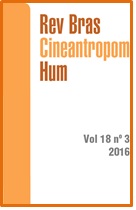Effects of tapering on maximum aerobic power in indoor soccer players
DOI:
https://doi.org/10.1590/1980-0037.2016v18n3p341Abstract
The aim of this study was to analyze the effect of tapering on maximum aerobic power (VO2max) in young male indoor soccer athletes. Participants were 78 athletes aged 12-17 years randomly divided into experimental (EG) and control group (CG). Both groups did the same training planning until the last three weeks (tapering phase). Only EG performed tapering. Tapering lasted three weeks adopting the linear tapering method. VO2max was estimated by Yo-Yo intermittent Recovery Level 1 early in the season and in the last week of each. Univariate analysis of covariance (ANCOVA) was conducted for repeated measures to compare VO2max among groups according to mesocycle. The results presented effect of time (F (4.74)= 42.02, p = 0.01) and group (F (2.76) = 35.87, p = 0.01). Overall, the findings of this study suggest that the implementation of the tapering strategy in the last weeks of training is more efficient to improve VO2max than the constant maintenance of loads.



